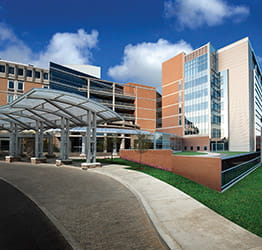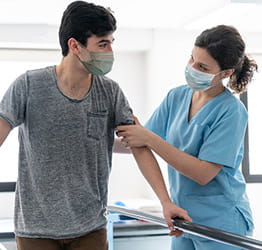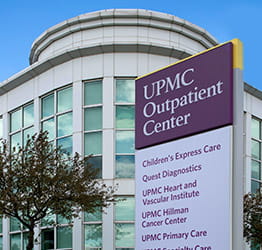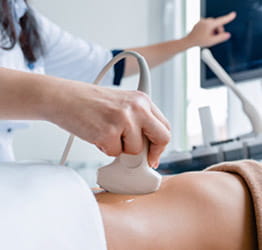From her first period at age 12, Kacey Sullinger experienced daily — and often excruciating — pain. The severe cramping, heavy bleeding, nausea, and constipation would last 10 to 12 days.
“I didn’t know any different,” says Kacey, 26. “I thought this was normal, so I continued with my activities as best I could.”
Naturally athletic and competitive, the South Allegheny native lettered in three high school sports. She also played four years of college soccer.
“I refused to allow the pain to stop me from competing; but in hindsight, I rarely performed at my highest level,” she says.
The Challenge: Undiagnosed Endometriosis and Chronic Pain
Kacey didn’t know it, but she had endometriosis, a silent condition in which cells similar to the lining of the uterus grow in other areas of the pelvis or abdomen. It can lead to constant pelvic and menstrual pain.
As her endometriosis spread, Kacey developed issues with her bladder and bowels. She tried to seek help in her teenage years, but her complaints were ignored.
“My pediatrician said I was too active and didn’t miss enough school for it to be that serious,” she says. “My mom just thought it was normal.”
It wasn’t until she developed an incisional umbilical hernia after an emergency appendectomy in 2016 that Kacey first heard the word “endometriosis.” Unexpectedly, an abdominal CT scan revealed a medium-sized ovarian cyst — a sign of the disease.
“I was referred to an ob-gyn who told me I most likely had endometriosis,” says Kacey, who was then 17. “The doctor said that the only treatment was birth control and that surgery would be futile.”
Although birth control shortened the length of her period to one week, it did little for her pain and heavy bleeding.
“I accepted that I would just have a life of painful periods,” says Kacey.
She powered through her debilitating symptoms, earning an undergraduate degree at the University of Pittsburgh Johnstown. She then spent a year abroad at Trinity College Dublin where she earned a Master of Science in immunology.
The Path to UPMC: A “Domino Effect” of Caring Doctors
Kacey returned to Pittsburgh in 2022 determined to find answers and relief. After a year of frustrating visits with doctors who offered little help, she found Janet Harrison, MD, a gastroenterologist and inflammatory bowel disease specialist at the UPMC Magee Digestive Disorders Center. It was life-changing.
“For the first time, I felt like someone listened to me, believed me, and wanted to help me.” Kacey says. “It started this amazing domino effect of finding medical providers who genuinely cared for me.”
Dr. Harrison diagnosed Kacey with irritable bowel syndrome with constipation (IBS-C), a condition characterized by abdominal pain, bloating, and hard or lumpy stools. In addition to the recommended dietary changes, she started pelvic floor therapy with Susan Boehl, DPT, at the UPMC Rehabilitation Institute to help ease her IBS symptoms.
Kacey then learned she had high-tone pelvic floor dysfunction — a common diagnosis in women with endometriosis. It’s a neuromuscular disorder in which overly tense pelvic floor muscles interfere with bowel and bladder movements.
When Susan learned about Kacey’s bladder symptoms — urinary retention, pain and burning while urinating, and negative urinary tract infection (UTI) results — she recommended that Kacey see Jocelyn Fitzgerald, MD, a urogynecologist and reconstructive pelvic surgeon at UPMC Magee.
The Solution: A Team Approach
Dr. Fitzgerald agreed that Kacey’s urinary symptoms were likely due to endometriosis. She also diagnosed Kacey with female bladder pain syndrome, also known as interstitial cystitis (IC) — a condition characterized by chronic and painful urinary symptoms. IC is nicknamed the “evil twin” of endometriosis because it frequently occurs at the same time.
Dr. Fitzgerald reports that her patient population reveals close to 80% of women with painful bladder symptoms and negative urine cultures have been since diagnosed with endometriosis.
“There is still so much we don’t know about endometriosis and the bladder,” Dr. Fitzgerald says. “But we do know that there are multiple pain pathways that are activated and affect bladder sensation as a result of being in an inflammatory environment like endometriosis.”
Unlike her previous doctors, Dr. Fitzgerald said surgery was a viable option for symptom relief. She referred Kacey to Sarah Allen, MD, a minimally invasive gynecologic surgeon at the Endometriosis Center at Magee.
“Dr. Fitzgerald wanted to do a cystoscopy and administer steroid injections to address my pelvic floor dysfunction and IC. She suggested doing the procedure in combination with a laparoscopy by Dr. Allen to diagnose and remove any endometriosis,” says Kacey.
Dr. Allen switched Kacey to a different hormonal therapy to reduce endometriosis symptoms while she waited for surgery. The laparoscopy procedure would require using her belly button as a port site where she had a likely hernia. Dr. Allen recommended briefing a general surgeon in case a hernia repair was needed. She referred Kacey to Karla Bernardi, MD, a minimally invasive bariatric and general surgeon at Magee.
Dr. Bernardi scheduled an abdominal CT scan to examine the area and found not one, but two abdominal hernias. She recommended proceeding with a mesh repair due to the size of the hernias.
Thanks to the close collaboration of her doctors, each of Kacey’s proposed surgeries could be done at once — all using minimally invasive technology.
The Results: Relief From Pain and Symptoms
On Dec. 17, 2024, all three doctors were at Kacey’s side when she went into surgery at Magee. Dr. Fitzgerald went first, using a slender, flexible cystoscope inserted through the urethra to examine her “inflamed and angry” bladder. She then cauterized the lesions and administered steroids as well as performed trigger-point injections to her spastic pelvic floor muscles.
Next was Dr. Allen, who used a laparoscope inserted through Kacey’s belly button to examine her pelvic organs. She removed tissue from the lining of Kacey’s abdominal cavity that later tested positive for endometriosis. Dr. Bernardi then performed the final procedure — a robotic-assisted mesh-augmented hernia repair — using the same port sites to insert the camera and robotic instruments.
Before surgery, Kacey’s biggest fear was that the three doctors wouldn’t find anything.
“After 13 years of debilitating symptoms, I was afraid of the possibility my previous providers were right — that nothing was wrong, and it was all in my head,” she says. “Ultimately, I trusted my doctors. I needed this surgery, and it was worth it.”
After five hours of surgery, Kacey went home that night with a temporary catheter that was removed a few days later. She initially experienced some pain from the hernia procedure, but it subsided after a couple days. Her debilitating endometriosis symptoms have since settled down or disappeared completely, and her bowel and bladder function no longer interfere with her daily life. She has resumed an active lifestyle that includes running, hiking, and officiating high school soccer.
“Magee was the first place where I felt listened to as a woman and cared for as a person,” says Kacey. “It took one doctor who believed me to set off this whole chain reaction.
“I’m so thankful for these three doctors — all women — who took care of me. By doing my operation together at one time, they saved me from multiple procedures, time away from work, and a lot of money.”
Kacey, a research scientist and lab manager at the Byrne Lab at the UPMC Vision Institute, says her Magee doctors have motivated her to pursue a career in women’s health as a physician-scientist.
“Every interaction I have with these three surgeons and Dr. Harrison inspires me,” she says. “I hope one day I can treat patients the way they treated me. We need more providers, especially for women, who believe in and advocate for their patients.”

















